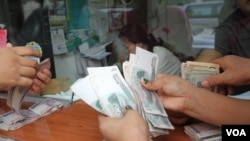The National Bank of Cambodia announced on Friday a new plan to phase-out circulation of small-denominated U.S. dollar bills in the country’s highly-dollarized economy, creating some confusion among citizens if these bills had been banned outright.
In a press release, the National Bank of Cambodia (NBC) said it would phase out the $1, $2, $5 bills, while pushing for the use of the Cambodian riel. The statement was released after a meeting with bank and MFI representatives.
This would be done by giving commercial banks and microfinance institutions three months, ending August 31, to send small bills in their possession back to the NBC, thereby removing them out of circulation. While the NBC said small denominated bills were still legal tender, banks and MFIs would be expected to incur costs of transporting these bills after August 31.
“Cambodia has to encourage the use of its riel more. So, allowing the circulation of small U.S. bills is an obstacle in urging the use of the riel,” the NBC press statement read.
Cambodia has a highly dollarized economy due to various factors such as the low confidence in the riel following the Khmer Rouge regime and the huge influx of U.S. dollars, to the tune of $1.7 billion, during the United Nations Transitional Authority in Cambodia in 1991-1992.
NBC added that in the last six months the riel and other regional currencies had decreased in value compare to the U.S. dollar. This had caused a reduction in demand for the riel, the NBC explained, affecting economic activity, especially in rural farming households.
The decision did create some confusion as to whether the $1, $2, $5 bills – mainstays at Cambodian markets – were being banned with immediate effect. Social media posts showed that some vendors were hesitant or refusing to accept these bills.
Prime Minister Hun Sen, the Association of Banks in Cambodia and the Cambodia Microfinance Association were quick to release statements ensuring consumers and citizens that small denominated bills were still legal and that people should continue to use them.
“The $1, $2 and $5 notes are still ordinarily used in Cambodia,” he said in a post on Facebook last Friday. “There is no prohibition like rumor being spread.”
Financial experts and economists agreed that the move benefit promote the use of Cambodian Riel and help NBC on the cost.
Stephen Higgins, a managing partner at Mekong Strategic Partners, supported the move and said Cambodians could easily substitute the use of smaller U.S. dollar bills with existing riel denominations.
“Over time, people will find less of these notes in circulation, but they will still be around. Plus, people can easily use KHR5000 and KHR20000 notes anyway. It really shouldn’t have much impact on people,” he said in an email.
He added that while the U.S. dollar had served the economy well, the transition to a riel-dominated financial system was needed to give the National Bank of Cambodia more control over managing the economy.
Jayant Menon, a visiting senior fellow at ISEAS-Yusof Ishak Institute, a think tank based in Singapore, said the challenge would be to phase out the U.S. dollar, with the aim of eventually having an all-riel economy, but at the same time trust and confidence in the Khmer riel needs to be increased.
“But to fully de-dollarise, the riel needs to be trusted as a reliable store of value. This will take more time, and will involve improving economic, financial and governance issues. It also has to happen naturally, and cannot be legislated.”
Ou Virak, president of public policy organization Future Forum, told VOA that the move would require some adjustment for small traders, who uses these bills, as well as tourists.
“They have to change money to riel first, and then they have to change from riel back to their own currency,” he said.







